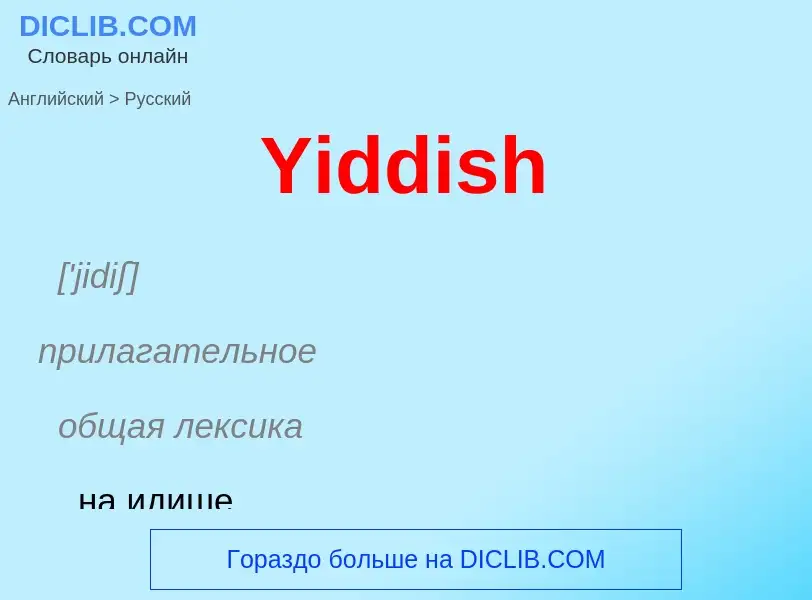Перевод и анализ слов искусственным интеллектом ChatGPT
На этой странице Вы можете получить подробный анализ слова или словосочетания, произведенный с помощью лучшей на сегодняшний день технологии искусственного интеллекта:
- как употребляется слово
- частота употребления
- используется оно чаще в устной или письменной речи
- варианты перевода слова
- примеры употребления (несколько фраз с переводом)
- этимология
Yiddish - перевод на русский
['jidiʃ]
прилагательное
общая лексика
на идише
на еврейском языке
существительное
['jidiʃ]
общая лексика
идиш
еврейский язык
еврейский язык, идиш
[dʒudi:ə(u)'dʒə:mən]
существительное
общая лексика
идиш
Определение
Википедия

Yiddish (ייִדיש, יידיש or אידיש, yidish or idish, pronounced [ˈ(j)ɪdɪʃ], lit. 'Jewish'; ייִדיש-טײַטש, Yidish-Taytsh, lit. 'Judeo-German') is a West Germanic language historically spoken by Ashkenazi Jews. It originates from 9th century Central Europe, providing the nascent Ashkenazi community with a vernacular based on High German fused with many elements taken from Hebrew (notably Mishnaic) and to some extent Aramaic. Most varieties of Yiddish include elements of Slavic languages and the vocabulary contains traces of Romance languages. Yiddish is primarily written in the Hebrew alphabet.
Prior to World War II, its worldwide peak was 11 million, with the number of speakers in the United States and Canada then totaling 150,000. Eighty-five percent of the approximately six million Jews who were murdered in the Holocaust were Yiddish speakers, leading to a massive decline in the use of the language. Assimilation following World War II and aliyah (immigration to Israel) further decreased the use of Yiddish among survivors after adapting to Hebrew in Israel. However, the number of Yiddish-speakers is increasing in Hasidic communities. In the 1990s, there were around 1.5–2 million speakers of Yiddish, mostly Hasidic and Haredi Jews. A 2021 estimate from Rutgers University was that there were 250,000 American speakers, 250,000 Israeli speakers, and 100,000 in the rest of the world (for a total of 600,000).
The earliest surviving references date from the 12th century and call the language לשון־אַשכּנז (loshn-ashknaz, "language of Ashkenaz") or טײַטש (taytsh), a variant of tiutsch, the contemporary name for Middle High German. Colloquially, the language is sometimes called מאַמע־לשון (mame-loshn, lit. "mother tongue"), distinguishing it from לשון־קודש (loshn koydesh, "holy tongue"), meaning Hebrew and Aramaic. The term "Yiddish", short for Yidish Taitsh ("Jewish German"), did not become the most frequently used designation in the literature until the 18th century. In the late 19th and into the 20th century, the language was more commonly called "Jewish", especially in non-Jewish contexts, but "Yiddish" is again the most common designation today.
Modern Yiddish has two major forms. Eastern Yiddish is far more common today. It includes Southeastern (Ukrainian–Romanian), Mideastern (Polish–Galician–Eastern Hungarian) and Northeastern (Lithuanian–Belarusian) dialects. Eastern Yiddish differs from Western both by its far greater size and by the extensive inclusion of words of Slavic origin. Western Yiddish is divided into Southwestern (Swiss–Alsatian–Southern German), Midwestern (Central German), and Northwestern (Netherlandic–Northern German) dialects. Yiddish is used in a number of Haredi Jewish communities worldwide; it is the first language of the home, school, and in many social settings among many Haredi Jews, and is used in most Hasidic yeshivas.
The term "Yiddish" is also used in the adjectival sense, synonymously with "Ashkenazi Jewish", to designate attributes of Yiddishkeit ("Ashkenazi culture"; for example, Yiddish cooking and "Yiddish music" – klezmer).


![1917. 100 [[karbovanets]] of the Ukrainian People's Republic. Revers. Three languages: Ukrainian, Polish and Yiddish. 1917. 100 [[karbovanets]] of the Ukrainian People's Republic. Revers. Three languages: Ukrainian, Polish and Yiddish.](https://commons.wikimedia.org/wiki/Special:FilePath/100karbovantsevUNR R.jpg?width=200)
![A typical poster-hung wall in a Jewish section of [[Brooklyn]], New York A typical poster-hung wall in a Jewish section of [[Brooklyn]], New York](https://commons.wikimedia.org/wiki/Special:FilePath/Brooklyn Posters 1.jpg?width=200)
![NEP]]-era Soviet Yiddish poster "Come to us at the [[Kolkhoz]]!" NEP]]-era Soviet Yiddish poster "Come to us at the [[Kolkhoz]]!"](https://commons.wikimedia.org/wiki/Special:FilePath/Drive to the Collective Farm.jpg?width=200)
![Polish]], advertising English classes for new immigrants in [[Cleveland]] Polish]], advertising English classes for new immigrants in [[Cleveland]]](https://commons.wikimedia.org/wiki/Special:FilePath/Inviting Immigrants to Cleveland Poster (6279784636).jpg?width=200)



![Jewish Autonomous Oblast]] in Russia Jewish Autonomous Oblast]] in Russia](https://commons.wikimedia.org/wiki/Special:FilePath/RussiaJewish2007-07.png?width=200)
![revolutionary year 1848]]. In the collection of the [[Jewish Museum of Switzerland]]. revolutionary year 1848]]. In the collection of the [[Jewish Museum of Switzerland]].](https://commons.wikimedia.org/wiki/Special:FilePath/Süd-West-Jiddische Lebensbeschreibung.jpg?width=200)
![Women surrounded by posters in English and Yiddish supporting [[Franklin D. Roosevelt]], [[Herbert H. Lehman]], and the [[American Labor Party]] teach other women how to vote, 1936. Women surrounded by posters in English and Yiddish supporting [[Franklin D. Roosevelt]], [[Herbert H. Lehman]], and the [[American Labor Party]] teach other women how to vote, 1936.](https://commons.wikimedia.org/wiki/Special:FilePath/Women voter outreach 1935 English Yiddish.jpg?width=200)

![Allies]] with wheat – Let nothing go to waste". Colour lithograph, 1917. Digitally restored. Allies]] with wheat – Let nothing go to waste". Colour lithograph, 1917. Digitally restored.](https://commons.wikimedia.org/wiki/Special:FilePath/Yiddish WWI poster2.jpg?width=200)
